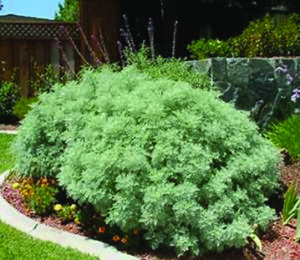By Emmy Ulmschneider
Master Gardener
Chances are that you may not be familiar with the genus Artemisia, but drive from Midland west and you have seen the silver-gray sage so common in our dry western landscapes. Artemisia is a large genus (200-400 species) in the family Asteraceae which includes sunflowers and daisies. Worldwide, wherever it thrives, it has a close and long association with human cultures who made use of its aromatic, medicinal and culinary properties. If you have used culinary tarragon in cooking, smelt a burning sage bundle, or tasted the liqueur absinthe or the aperitif vermouth, you have experienced this plant. Before we look at growing this plant in our gardens, let’s learn a little about its history.

The genus is named for Artemis, Apollo’s twin sister and the Greek goddess of hunting and wilderness. From China, through the Middle East and Europe, members of this widely distributed genus have been used a culinary flavoring and medicinally for a variety of ailments. North American indigenous people used white sage, Artemisia ludoviciana, as a staple medicinal plant as well as a ceremonial plant to purify and cleanse. Their color it provides enlivens a holiday wreath or garland.
In a genus so large, there are the good, the bad and the ugly species. One cultivar, Powis Castle, is widely grown in our area and received the Royal Horticultural Society’s Award of Garden Merit in 1993. Like most artemisias, Powis Castle is valued for its silvery-white foliage, it’s aromatic scent and ease of growing. It grows as a silvery mound, 1-3” tall and if not trimmed may spread from 3-6”. It is perfect for poor, dry soil and full sun but will tolerate shade.
On the other side of the spectrum, are the cultivars of our native artemisia, Artemisia ludoviciana, such as Silver King and Silver Queen. They are grown for their texture and color providing a 2 to 3” silvery white contrast to the plants surrounding them. They thrive in tough conditions: dry, shallow soils. They do not perform well in moist wet soils becoming leggy and floppy.
Artemisia in general provide forage and cover for our native wildlife including both small mammals, deer as well as birds. In our gardens, they provide nesting material and structure for native bees and pollinators.
So, if you could use a contrast color in an existing bed or a groundcover in a hot, hard to grow place, as well as a connection to the past, this is the plant for you.
For more information, call the AgriLife office at 498-4071 in Odessa or at 686-4700 in Midland or visit aggie-horticulture.tamu.edu or westtexasgardening.org.




